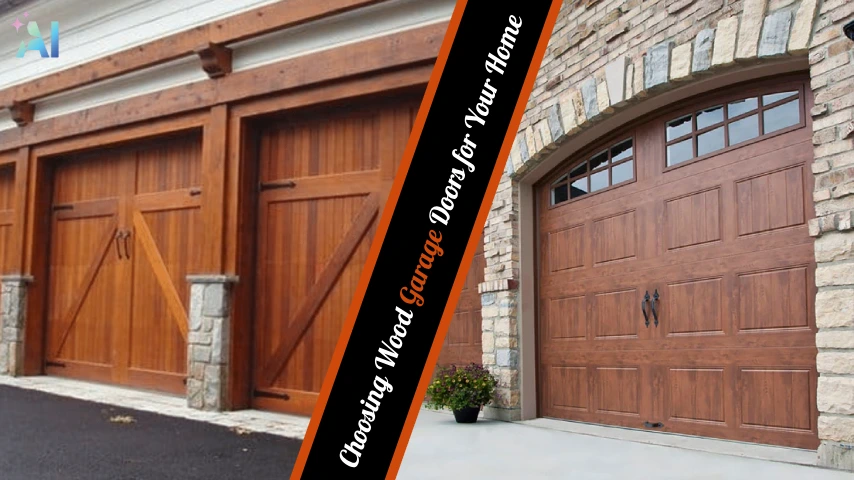Choosing wood garage doors for your home can transform your property’s curb appeal while providing functionality and durability. These doors offer a unique blend of classic beauty and modern performance, making them a popular choice for homeowners who want to make a statement. In this article, we’ll explore everything you need to know about wood garage doors, from types and styles to costs and maintenance, helping you make an informed decision for your home.
Introduction
Wood garage doors have been a staple in home design for decades, and for good reason. They bring a warmth and character that’s hard to match with other materials. When you choose a wood garage door, you’re not just picking a functional piece of your home; you’re selecting a focal point that can dramatically enhance your property’s overall look.
These doors come in various styles, from rustic carriage house designs to sleek, modern panels. They can be customized to fit any architectural style, making them versatile enough for both traditional and contemporary homes. But their appeal isn’t just skin deep. Wood garage doors also offer practical benefits like natural insulation and durability when properly maintained.
Types of Wood for Garage Doors
When it comes to choosing wood for your garage door, you’ve got options. Each type of wood brings its own unique characteristics to the table.
Common wood species used
- Cedar: Known for its natural resistance to decay and insects, cedar is a popular choice. It’s lightweight yet durable and has a beautiful grain pattern.
- Redwood: This wood is prized for its rich color and natural resistance to rot. It’s also less likely to warp or shrink compared to other woods.
- Mahogany: If you’re after a luxurious look, mahogany might be your go-to. It’s known for its deep, reddish-brown hue and excellent durability.
- Pine: As a more affordable option, pine is lightweight and easy to work with. It takes stains and paints well, allowing for versatile customization.
Pros and cons of each wood type
Each wood type has its strengths and weaknesses. Cedar and redwood are naturally resistant to decay but can be more expensive. Mahogany offers unparalleled beauty but comes with a higher price tag. Pine is budget-friendly but may require more maintenance over time.
For example, cedar garage doors provide a range of colors from light blonde to warm brown and offer natural decay resistance. But they might need more frequent sealing to maintain their appearance. On the other hand, redwood garage doors are known for their superior quality and natural beauty, but they can be prone to warping in extreme temperatures.
Styles and Designs
Wood garage doors come in a variety of styles to suit any home’s architecture.
Popular wood garage door styles
- Carriage House: These doors mimic the look of old-fashioned carriage house doors but operate like modern overhead doors. They often feature decorative hardware and windows for added charm.
- Raised Panel: This classic style features rectangular panels raised from the door’s surface, creating depth and visual interest.
- Flush Panel: For a more contemporary look, flush panel doors offer a clean, streamlined appearance. They’re perfect for modern home designs.
- Craftsman: These doors often feature clean lines and natural wood grains, complementing Arts and Crafts or Craftsman-style homes.
Customization options
One of the biggest perks of wood garage doors is their customizability. You can choose from various wood stains to achieve the exact look you desire, whether it’s a rustic farmhouse vibe or a sleek, modern design. You can also add windows in different shapes and sizes, or include decorative hardware like hinges and handles to enhance the door’s appearance.
Some manufacturers even offer the option to create fully custom designs. This means you can work with a designer to create a unique door that perfectly matches your home’s style and your personal taste.
What are the Benefits of Wood Garage Doors?
Wood garage doors offer several advantages that make them a compelling choice for many homeowners.
Aesthetic appeal
There’s no denying the natural beauty of wood. It brings warmth and character to your home’s exterior that’s hard to replicate with other materials. Wood doors can be stained or painted in a wide range of colors, allowing you to perfectly match or complement your home’s exterior.
Durability and strength
When properly maintained, wood garage doors can be incredibly durable. They’re resistant to dents and dings that might easily damage metal doors. Plus, if a section does get damaged, it’s often easier and less expensive to repair or replace a single panel on a wood door compared to other materials.
Insulation properties
Wood is a natural insulator, which means it can help regulate the temperature in your garage. This can be particularly beneficial if you have a living space above your garage or if you use your garage as a workshop. Better insulation can lead to energy savings and a more comfortable environment.
Cost Considerations
While wood garage doors offer many benefits, they typically come with a higher price tag than other materials.
Price range for wood garage doors
On average, you can expect to spend anywhere from $1,000 to $5,000 for a wood garage door, including purchase and installation. However, prices can go higher for premium designs or custom-made doors.
Factors affecting cost
Several factors can influence the cost of your wood garage door:
- Wood type: Premium woods like mahogany or redwood will cost more than pine or cedar.
- Size: Larger doors or non-standard sizes will be more expensive.
- Design complexity: Carriage house styles or doors with intricate detailing will cost more than simpler designs.
- Customization: Adding windows, decorative hardware, or opting for custom designs will increase the price.
- Insulation: Insulated doors cost more but can provide energy savings in the long run.
Remember, while the initial cost might be higher, wood doors can add significant value to your home, potentially making them a worthwhile investment.
Maintenance Requirements
To keep your wood garage door looking its best and functioning properly, regular maintenance is key.
Cleaning and care tips
- Regular cleaning: Wash your door with mild soap and water at least twice a year to remove dirt and debris.
- Inspect for damage: Check for any signs of wear, cracks, or water damage regularly.
- Refinishing: Every few years, you may need to refinish your door to protect the wood and maintain its appearance.
- Weather-stripping: Check and replace weather-stripping as needed to prevent drafts and moisture intrusion.
Frequency of maintenance
The frequency of maintenance will depend on your climate and the type of wood. In general, plan on inspecting your door at least twice a year and refinishing every 2-5 years. Doors exposed to harsh weather conditions may need more frequent care.
While this might seem like a lot of work, many homeowners find that the beauty and character of wood doors make the extra maintenance worthwhile.
How Do Wood Doors Compare to Other Materials?
Wood isn’t the only option for garage doors. Let’s see how it stacks up against other popular materials.
Wood vs. steel
Steel doors are generally less expensive and require less maintenance than wood. They’re also highly durable and can be insulated for energy efficiency. However, they lack the natural warmth and character of wood and can dent more easily.
Wood doors, on the other hand, offer superior aesthetics and can be more easily repaired if damaged. They also provide natural insulation, though not as efficiently as insulated steel doors.
Wood vs. fiberglass
Fiberglass doors are lightweight, low-maintenance, and resistant to dents and rust. They can be designed to mimic the look of wood without the upkeep. However, they may not be as durable in extreme temperatures and lack the authentic feel of real wood.
Wood doors offer better insulation than fiberglass and have a timeless appeal that’s hard to replicate. While they require more maintenance, many homeowners feel the natural beauty is worth the extra effort.
Installation Process
Installing a wood garage door isn’t typically a DIY project due to the weight of the doors and the complexity of the spring system.
Professional vs. DIY installation
Professional installation is strongly recommended for wood garage doors. These doors are heavy, and improper installation can lead to safety hazards and poor door performance. Professional installers have the tools and expertise to ensure your door is installed correctly and functions safely.
What to expect during installation
During installation, professionals will:
- Remove the old door and hardware
- Install the new tracks and springs
- Hang the new door panels
- Install and adjust the opener
- Test the door for proper operation and balance
The process typically takes 3-5 hours for a standard installation.
Longevity and Durability
With proper care, wood garage doors can last for many years.
Expected lifespan of wood garage doors
On average, a well-maintained wood garage door can last 15-30 years. This longevity makes them a good long-term investment for many homeowners.
Factors affecting durability
Several factors can impact the lifespan of your wood garage door:
- Climate: Exposure to extreme temperatures, humidity, or salt air can affect the door’s durability.
- Maintenance: Regular care and timely repairs can significantly extend the life of your door.
- Usage: Frequent use can lead to more wear and tear.
- Quality of installation: Proper installation is crucial for long-term performance.
Environmental Considerations
For environmentally conscious homeowners, wood garage doors can be an eco-friendly choice.
Sustainability of wood as a material
Wood is a renewable resource, and many manufacturers use sustainably harvested timber. Look for doors certified by the Forest Stewardship Council (FSC) to ensure the wood comes from responsibly managed forests.
Energy efficiency of wood doors
Wood is a natural insulator, which can help improve your home’s energy efficiency. While not as efficient as specially insulated doors, wood doors can help maintain a more consistent temperature in your garage, potentially reducing your energy costs.
Conclusion
Choosing wood garage doors for your home is a decision that balances aesthetics, functionality, and long-term value. While they require more maintenance and come with a higher initial cost, wood doors offer unparalleled beauty and character that can significantly enhance your home’s curb appeal.
From the warm tones of cedar to the rich hues of mahogany, wood doors provide a range of options to suit any architectural style. They’re highly customizable, durable when well-maintained, and can even contribute to your home’s energy efficiency.
Remember, the key to getting the most out of your wood garage door is proper installation and regular maintenance. With the right care, your wood garage door can be a beautiful and functional part of your home for decades to come.
Ultimately, the decision to choose a wood garage door comes down to your personal preferences, budget, and willingness to commit to maintenance. If you value natural beauty, customization options, and are willing to invest in regular upkeep, a wood garage door could be the perfect choice for your home.





